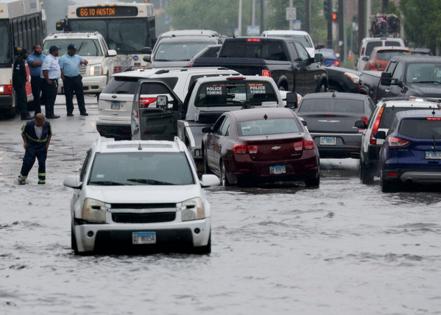
Are cities to blame for our climate change quagmire?
In his new book “The Earth Transformed: An Untold History,” University of Oxford historian Peter Frankopan argues that the intractability of climate change politics comes from the remarkable success of cities in lifting people out of poverty, transforming standards of living and improving human lives. These success stories unfortunately come with an enormous cost: Cities are densely packed creations that require assaults on the natural world.
Frankopan’s urgent goal is to write a history that can carry us beyond our human-centered focus, reintegrate history and nature, and make the human story a natural history. He is writing history as a cautionary tale that roots our environmental and climate challenges in human overreach.
Civilization, as embodied by cities, is the villain, in other words.
Frankopan writes that civilization “is by far the single greatest factor in environmental degradation and the most important cause of anthropogenic climate change — because of the demands that the populations of cities place on energy and on the consumption of natural resources, including food and water.”
Cities and civilizations have always been about a competition between humans and nature that has required nature to lose, Frankopan writes. The life of cities has almost always depended upon the death of nature.
Urban ecologist Dickson Despommier, on the other hand, celebrates cities for their economic energy, creative vitality and resilience, which he attributes to their density and their complex organization.
By contrast, Frankopan sees cities as inherently problematic. The population density and scaling properties of cities have allowed rulers to consolidate and project power, mobilize massive armies, subdue surrounding populations, build states and empires, and ravage the environment. These emerging cities and states are “parasites” living off the labor and natural resources of surrounding territories, he argues.
He also believes that the sheer size of cities makes them uniquely vulnerable to climate events such as drought and flooding and to human-caused events such as wars, triggering labor and food shortages and environmental degradation.
“As history shows only too well,” he writes, “the past has been shaped by … empires forming and then collapsing — usually at speed. Rather than being too big to fail, increasing size and complexity create their own momentum that can lead to a house of cards tumbling down chaotically, quickly and decisively.”
The complex social, political, cultural and technological systems that accelerate the growth of cities to unimaginable scale are inherently fragile because they ultimately depend upon the carrying capacity of the surrounding environment, which a city’s growth undermines.
In Frankopan’s telling, the parasitic dynamics of city-building and state-building seem not to have changed much from 5,000 years ago, when the first cities and empires emerged in Mesopotamia, the Nile Valley, the Yellow and Yangtze River regions of China, the Indus Valley in South Asia and the valleys of the Andes.
In the 17th and 18th centuries, the economic exchanges that happened across the globe resulting from the Age of Discovery, the colonization of the Americas and the establishment of the African slave trade poured wealth into European urban centers where political and economic elites lived. The process boosted consumption of commodities such as sugar, coffee, tea, tobacco, wood and precious metals extracted from colonized lands.
In this period, European cities grew enormously to accommodate the demand for services and infrastructure on which global trade depended. Large-scale urbanization intensified production and consumption and enabled engagement with other parts of the world, ultimately unleashing the Industrial Revolution. As is the case today, these consumption patterns exacted terrible environmental and human costs in the distant regions where production of these commodities occurred. (Deforestation and depletion of groundwater and topsoil are three of the most notable examples.)
In the 21st century, urbanization has only accelerated across the world. Over four decades, hundreds of millions of Chinese moved from rural areas to cities, with the urban population in China increasing from 18% to 60%. Between 2011 and 2013 alone, China poured more concrete than the United States did throughout the entire 20th century, pumping vast amounts of carbon dioxide into the atmosphere.
But China is not alone. Cities are projected to hold 70% of the world’s population by 2050. They directly generate more than 70% of greenhouse gas emissions. These numbers do not account for the environmental harms of resource extraction on which urban wealth and consumption depend.
And so in “The Earth Transformed,” Frankopan alerts us to a troubling paradox. Cities offer the promise of a better life for billions of people. But the economic activities and processes required to provide this better life are also the source of climate change. And as prospects for humans improve, the world is heating up more rapidly.
Frankopan thus leaves us with profoundly challenging and worrisome questions about how we might reconcile the choices we may need to make, willingly or not, between population growth and economic prosperity and climate and environmental disaster.
Is it possible for us to reimagine our future so that both humans and nature can flourish together as friends rather than as enemies?
____
Peter Schwartz writes at the broad intersection of philosophy, politics, history and religion. He publishes the Wikidworld newsletter on Substack.
___
Disclaimer: The views and opinions expressed are those of the writers and do not necessarily reflect the views or positions of any entities we represent.
©2024 Chicago Tribune. Visit at chicagotribune.com. Distributed by Tribune Content Agency, LLC.














